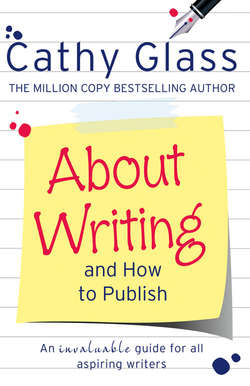Читать книгу About Writing and How to Publish - Cathy Glass, Cathy Glass - Страница 14
Оглавление
The layout of your work is very important when you submit it to a literary agent or publisher, so you will need to follow their guidelines. These can be found on their website or in their entry in writers’ handbooks such as the Writers’ and Artists’ Yearbook. However, while your work is under composition, you can use whatever layout or font suits you. I use the font Arial, in size 12, which is also a standard format for submission. To adjust the font and font size go to the drop-down menu on your toolbar in your word-processing document. The number refers to the size of the characters – the higher the number, the larger the font size. I always work in double-spaced lines, which allows me room to annotate my work on the printed sheet and write in changes. Most agents and publishers will require you to submit your work in double-spaced lines too, even though you will be sending it electronically – by email. Line spacing can also be changed in the drop-down menu on the toolbar in your word-processing document.
Use black print type (it will already be set as the default), not any other colour, and not bold, and remember to paginate your work (that is, insert page numbers). Pagination isn’t usually a default setting on word-processing programs, so you will need to select it from the drop-down menu on your toolbar. Generally, the width of the left- and right-hand margins, as well as the depth of the headers and footers (the spaces at the top and bottom of the page), are preset and standard on your word-processing software, so you don’t have to worry about them. The top and bottom spaces on a page are usually 1 inch and the side margins are 1¼ inches, which are acceptable to agents and publishers. Don’t align the right-hand margin (which is also known as justifying the margin) as it will create false spaces between the words. The left-hand margin is justified by default, but leave the right-hand one ‘ragged’; that is, free.
Sentences, paragraphs and chapters need to be kept to similar lengths for ease of reading. You probably won’t have noticed this uniformity while you have been reading books, and that in itself is a good sign – it makes for a smooth and fluent read. There is obviously flexibility in the length of sentences, paragraphs and chapters, and while some genres (Mills & Boon romances and Quick Reads, for example) have more defined requirements, generally it is not a good idea to leap from a chapter of 5,000 words to a chapter of 15,000 words as the pacing will falter and may even be lost. If, while you are reading, you find yourself looking for the next chapter break then the chapter is very likely too long. You should find yourself suddenly at the end of a chapter, eager to turn the page for the start of the next and wanting to read on.
Likewise if you have to read a sentence a second or third time to make sense of it then the likelihood is that the sentence is too long – possibly with too many clauses – or it may have failed grammatically. A paragraph should contain only one main idea and the sentences within that paragraph should expand, develop and explain that idea. Take a look at a book you have recently enjoyed and you consider a good read, and then spend some time analysing its sentence, paragraph and chapter structure. I think you will see what I mean.
The first line of each new paragraph should be indented by one tab space (which will be preset on your word-processing package), and a reminder: a sentence starts with a capital letter and ends with a full stop. Do not use commas instead of full stops; they are different. Leave one character space between the end of a sentence and the start of the next. Chapter headings should be in bold, with a double-spaced line beneath, and before the start of the first sentence. Include a title page at the start of your work; an example of this is here.
